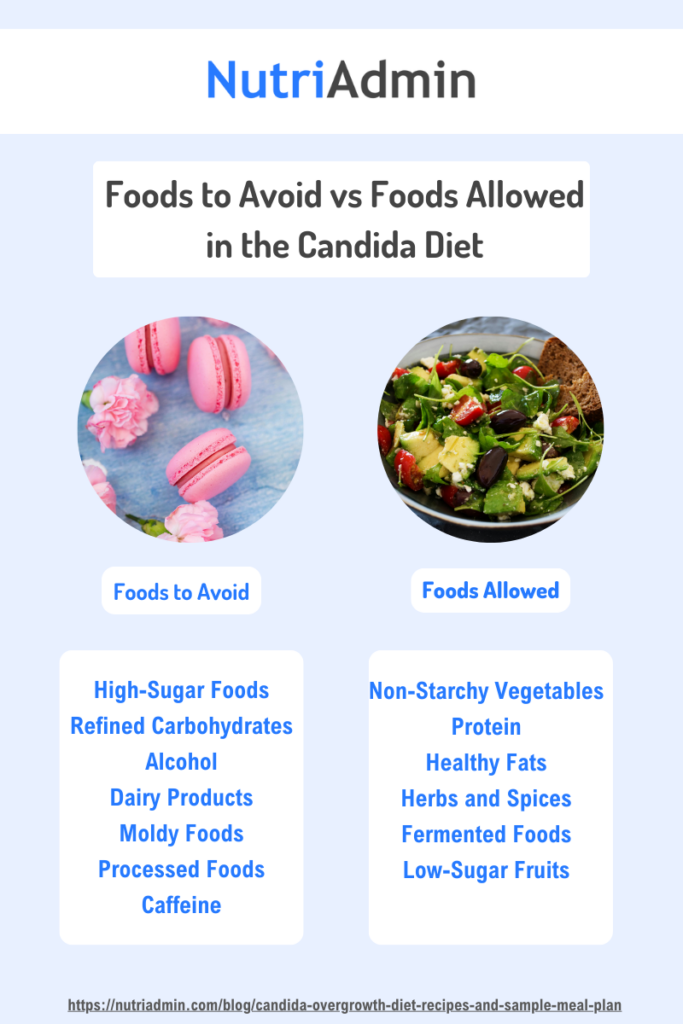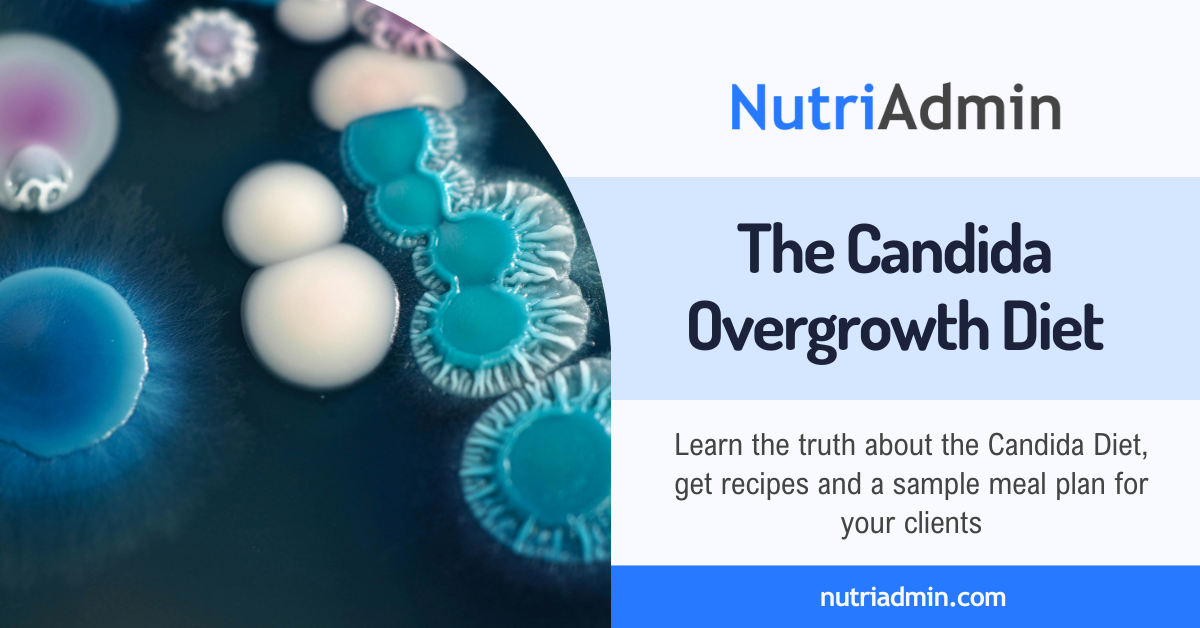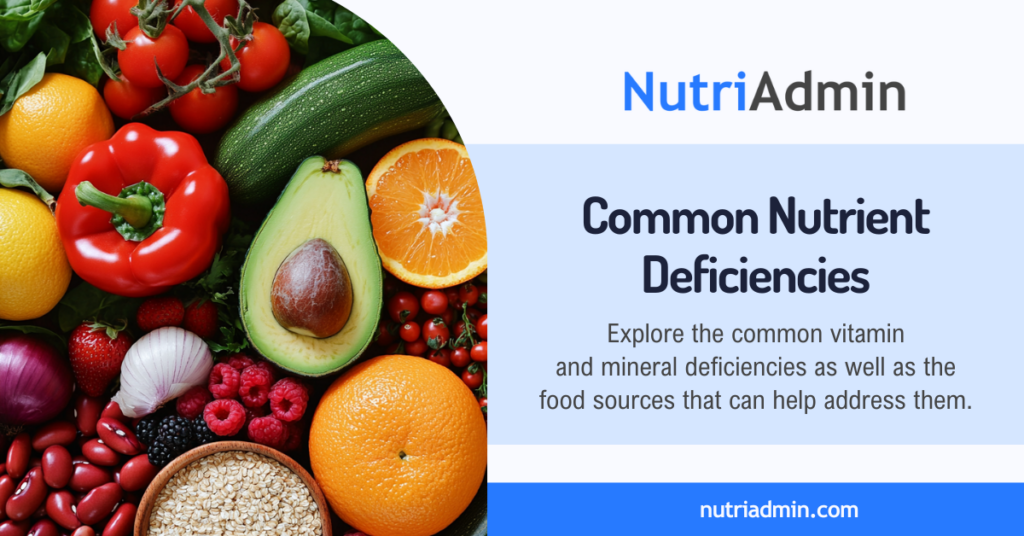Before we talk about the Candida overgrowth diet, let us consider these scenarios:
A 35-year-old woman walks into the consulting room. She is 6 months pregnant and complains of a white discharge from her vagina. There is some itching, but no other symptoms.
A 25-year-old male walks into the clinic with some whitish patches on his tongue. He is sexually active with an extended history of unprotected sex in the last year.
Who is the chief suspect in both cases?
As a medical doctor, I suspect Candida!
Now, Let us talk about Candida.
- What is Candidiasis?
- How to Diagnose Candidiasis?
- What is Candida Overgrowth?
- What are the Symptoms of Candidiasis?
- Risk Factors and People at Risk of Candida Overgrowth
- What is the Candida Overgrowth Diet?
- How Does the Candida Diet Work?
- Is the Candida Overgrowth Diet Effective?
- What are the Recipes for the Candida Diet?
- What is the Meal Plan for the Candida Diet?
- Supplements for Candida
- Conclusion
- FAQs
What is Candidiasis?
Candidiasis is an opportunistic infection caused by Candida. Candida is a genus of living organisms comprising more than 100 fungal species, and these species are the most common causes of fungal infection. Interestingly, only five species in the genus Candida cause more than 90% of infections.
These are Candida albicans, Candida tropicalis, Candida parapsilosis, Candida krusei, and Candida glabrata. Furthermore, these are also the species most commonly associated with Candidiasis.
| Candida Species | Percentage of Infections Caused |
|---|---|
| Candida albicans | 65.3% |
| Candida glabrata | 11.3% |
| Candida tropicalis | 7.2% |
| Candida parapsilosis | 6.0% |
| Candida krusei | 2.4% |
Candida species cause both systemic and superficial infections in humans. However, this is the exception, not the rule because they usually exist symbiotically with man. In fact, Candida albicans is part of the normal oral microflora. Between 30 and 50% of people carry this organism, and studies have shown that this percentage increases with age. Candida albicans also forms part of the esophageal and gastrointestinal mucosa.
How to Diagnose Candidiasis?
Clinical diagnosis: Healthcare providers can sometimes diagnose candidiasis by listening to the history of the symptoms and examining the patient.
Fungal culture: Healthcare providers may sometimes take a small sample from the mouth, throat, or vagina and send for a culture to determine if candida is present. This is the gold standard for diagnosing fungal infections. However, the presence of candida does not always mean, it is responsible for the symptoms. In invasive candidiasis, blood samples are taken and sent to the lab for culture. If candida is present, then it means candida may have invaded the bloodstream.
What is Candida Overgrowth?
As we have seen, Candida albicans is a normal part of the body’s microflora on the skin, in the mouth, esophagus, and gastrointestinal tract. However, a fungal infection can result when Candida grows out of control or the immune system weakens.
Candida overgrowth can occur in the mouth as oral thrush, in the vagina as a yeast infection, in the GIT, penis, or other parts of the body. On rare occasions, Candida can also invade the bloodstream. Moreover, the most common entry route is through the gastrointestinal mucous barrier, an intravascular catheter, or a localized infection.
Studies have shown that Candidiasis is more common in infancy and old age. Perhaps it is common in these age groups because they have lower immunity than the middle-aged and youth population. In the US, Oral thrush affects about 3 in 10 babies in the first few months of life.
Candidiasis is an opportunistic infection. This means it occurs more commonly in people with weakened immune systems than in those with intact or healthy ones. Hence, it is unsurprising that candidiasis is more common in older people and infants. Infants have immune systems that are just developing, while older adults have immune systems that are declining, and many may suffer from underlying chronic conditions.
Candidiasis is also very common among people living with HIV. HIV is a disease that attacks CD4 cells in the immune system, which are responsible for defending the body. With a weakened immune system, and without treatment, the body becomes vulnerable to all manner of opportunistic infections.
What are the Symptoms of Candidiasis?
How Candidaisis presents depends on the part of the body that it affects. In fact, most symptoms are benign, except in invasive candidiasis which is severe and has a fatality of about 25%.
| Body Part/System | Symptoms |
|---|---|
| Vagina | • Vaginal itching/pain • Abnormal vaginal discharge • Pain on urination |
| Mouth | • White non-scrapable rash/patch on tongue and oral mucous membranes • Loss of taste sensation • Pain on swallowing or eating |
| Invasive Candidaisis | • Fever and chills that are unresponsive to antibiotic treatment • Affects organs like in the brain, eyes, heart, and liver. |
Invasive Candidiasis
Invasive Candidiasis is commonly seen in immunocompromised patients with underlying conditions. Hence, it may be difficult to differentiate the symptoms of candidiasis from those of the diseases already present.
However, invasive Candidiasis can be suspected when fever and chills do not improve after antibacterial treatment. Organ-specific symptoms can also develop if candida spreads to other parts of the body such as the heart, the brain, bones, eyes, and joints.
Risk Factors and People at Risk of Candida Overgrowth
This section answers the question, “Who is most vulnerable to candida overgrowth?”
A general simple answer is that people who have a weakened immune system are most vulnerable to Candidiasis. This weakness can come from chronic disease conditions, extended use of certain medications, or even extended hospital stays.
- Pregnant women
- People with chronic illnesses eg DM, Cancer, Kidney failure
- People living with HIV/AIDS
- People on immunosuppressive medication eg chemotherapy, for tissue or organ transplants
- Autoimmune conditions
- Infants especially pre-term babies.
- Prolonged use of corticosteroids
- Prolonged Antibiotic use
- ICU patients
- People with a central venous catheter in situ
What is the Candida Overgrowth Diet?
The Candida overgrowth diet, also known as the candida diet or the Candida cleanse diet, focuses on avoiding foods and drinks that can increase the risk of candida overgrowth. It replaces these foods with lean proteins, probiotics, and nonstarch vegetables.
Foods to Consume on the Candida Diet
Here is a list of some foods that are believed to help limit and prevent candida overgrowth:
- Non-Starchy Vegetables: The diet allows vegetables like leafy greens, broccoli, cauliflower, Brussels sprouts, zucchini, and cucumber. These are low in sugars and can help support a healthy gut.
- Protein: Lean protein sources like poultry, fish, and grass-fed meat. Plant-based protein sources like tofu and tempeh.
- Healthy Fats: Foods rich in healthy fats, such as avocados, coconut oil, olive oil, and nuts (in moderation), are often part of the Candida diet.
- Herbs and Spices: Many herbs and spices, including garlic, ginger, turmeric, oregano, and cinnamon, have antifungal properties and are appropriate for flavoring.
- Fermented Foods: Some fermented foods like kefir, plain y
- ogurt (without added sugar), and sauerkraut can help promote the growth of beneficial gut bacteria.
- Low-Sugar Fruits: Berries like blueberries, raspberries, and blackberries in moderation due to their lower sugar content.

Foods to Limit or Avoid on the Candida Diet
There are some foods that can limit or reduce the body’s immunity or may make the conditions more favorable for the overgrowth of Candida. Here is a list of foods to avoid:
- Sugar and High-Sugar Foods: Candida thrives on sugar, so exclude all forms of sugar, including table sugar, honey, maple syrup, and high-sugar fruits.
- Refined Carbohydrates: Avoid processed foods, such as white bread, white rice, pasta, and other refined carbohydrates, as they can quickly convert to sugar in the body.
- Alcohol: Remove Alcohol, especially beverages with high sugar content like cocktails and beer as it can promote yeast overgrowth.
- Dairy Products: Many Candida diets recommend avoiding dairy or consuming dairy substitutes, as lactose in dairy can contribute to yeast growth.
- Moldy Foods: Moldy foods like aged cheeses, mushrooms, and certain nuts can exacerbate Candida symptoms.
- Processed and Packaged Foods: Highly processed foods often contain hidden sugars and additives.
- Caffeine: Some Candida diets suggest limiting caffeine intake, as it can affect gut health in some individuals.
How Does the Candida Diet Work?
The candida overgrowth diet proposes that avoiding the foods listed above and sticking with those allowed can reduce the risk of candida overgrowth, It also seeks to limit the inflammation and balance the bacteria concentration present in the gut.
A 2017 in-vitro study showed a direct relationship between candida growth and glucose concentration. So, the diet may work to eliminate sugars and other diets that promote candida growth. However, it is important to note that in this study about Candida and sugars, researchers did not use human subjects; hence, there is a need for further research.
Is the Candida Overgrowth Diet Effective?
It is very difficult to predict the influence of diet alone on the risk of developing Candida overgrowth, largely because so many factors are responsible for Candida growth. For instance, the use of antibiotics, immunosuppression, and underlying medical conditions all play a role in developing candidiasis. Hence, we would need further research before we can say authoritatively that the candida diet can prevent or cure candidiasis. As a matter of fact, in some cases, unless the underlying condition is treated, the individual may keep having recurrent candidiasis.
Furthermore, proponents of the Candida overgrowth diet claim that excluding gluten would prevent damage to the lining of the intestine. This is correct for people with gluten intolerance, but it has not been demonstrated in people without it.
The diet excludes dairy products on the basis that they may propagate the excess growth of candida. However, there is not enough evidence from research to confirm this.
The diet also excludes processed foods, foods with high mold content, and preservatives. Still, there is no evidence that these are associated with an increased chance of developing candidiasis.
Moreover, diet does not treat candidemia. Candidemia happens in rare cases, and when it does happen, it is usually in people with weakened immune systems, and antifungal medications are the choice of treatment. Note that chances are most people with candidemia are in the ICU, not surfing the Internet!
What are the Recipes for the Candida Diet?
As a nutritionist, you can create recipes for the Candida diet independently from scratch. You need to know the foods to avoid and those allowed for the diet. Then you may want to consider some client preferences too.
However, you may also use more automated solutions, like software that generates candida diet recipes. Several notable software programs are on the market, but one of the best is NutriAdmin. NutriAdmin can help you generate as many Candida Diet Recipes as you need.
Here are two examples from our rich database of diet recipes:
What is the Meal Plan for the Candida Diet?
Generally, the Candida diet meal plan includes foods that prevent excess Candida growth and reduce inflammation in the gut. As a nutritionist or personal trainer, you can manually generate a Candida diet meal plan or use meal plan generator applications like NutriAdmin to create several Candida meal plans for your clients.
You can check out this sample Candida meal plan below:
Supplements for Candida
Apart from antifungals and dietary modifications, research shows that some supplements may have some effect on Candida. These supplements limit Candida’s growth and populate the gut with bacteria that can keep candida in check.
Oregano
Oregano is a supplement that may be used to treat Candida infections. An in-vitro study carried out showed that Oregano was able to effectively reduce the growth of Candida albicans and some other Candida species. However, further research must be carried out to determine its efficacy in humans.
Probiotics
These are living microorganisms that can be consumed by humans. When consumed, these living organisms confer so many benefits. Research has shown that probiotics can be used to reduce the prevalence of elevated candida counts. Probiotics can be obtained in supplement form, and also from fermented foods. Some of these foods include Yoghurt, Kefir Tempeh, Kimchi, or Natto.
Caprylic acid
This refers to a fatty acid that occurs naturally in mammalian breast milk and it has been found to possess antifungal properties. A study discovered that this supplement has potent activity against candida and may have better activity than some commonly prescribed antifungals.
Fresh Garlic Extract
An in-vitro study was able to demonstrate that FGE has some level of activity against Candida. So it can serve as a supplement against the effects of candida.
Conclusion
The candida diet has many proponents worldwide. Many people have also benefitted from it, highlighting a feeling of better health and a higher quality of life. However, researchers have attributed some of these benefits to the restrictive diet. Cutting out processed foods, sugars, and fats and replacing them with lean proteins, nonstarchy vegetables, herbs, and spices would lead to a healthier diet and feeling.
Is it effective in preventing candida overgrowth?
Well, more large-scale studies would be needed to say authoritatively that it does this. But until then, there may be nothing wrong with trying a diet that is anti-inflammatory, anti-processed foods, and anti-sugar!
It is also important to state that not every gut symptom is due to Candida. There is a lot of information online about how candida can cause nausea, bloating, fatigue, and even brain fog. Some sources also exploit the rare but serious complications of invasive candidiasis as occurring even with milder conditions like thrush. Many of these claims have not been proven by reliable studies and research carried out over the years.
Finally, staying on a diet as restrictive as the Candida cleanse diet is very challenging, and not many people can sustain it for an extended period. For those who do, there is a risk of some nutrient deficiencies from this diet. Therefore, it is important that your doctor be informed about whatever diet you are on.




